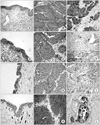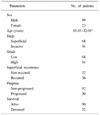Abstract
Purpose
A multi-subunit transcription factor NF-κB mediates the antiapoptotic signals in several cancer cell lines and it is activated in a broad range of human tumors. In this study, we investigated whether the expression levels of the NF-κB and the apoptosis inducing genes were related to the pathogenesis and clinical properties of human bladder tumor.
Materials and Methods
The expressions of NF-κB, BCL2-associated X protein (BAX), BCL2-associated death protein (BAD) and BH3-interacting domain death agonist protein (BID) were investigated by performing immunohistochemical staining on 133 archival bladder tissue paraffin blocks; these blocks included 122 transitional cell carcinomas of the urinary bladder and 11 normal bladder mucosae.
Results
The expression levels of NF-κB were significantly higher in the bladder tumors than those of the normal bladder mucosae (p=0.001). The expression levels of BAX in the superficial and low-grade (grade 1 and 2) bladder tumors were significantly enhanced more than those of the high-grade and invasive cases (p=0.042 and p=0.045, respectively), while the expression levels of BAD in the tumor tissues and low-grade tumors were significantly elevated compared with those of the normal mucosae and high grade tumor (p=0.007 and p=0.048, respectively). But the expressions of BID were not correlated with any pathologic and clinical properties.
Figures and Tables
 | Fig. 1The immunohistochemical staining. NF-κB in the (A) normal mucosa, (B) superficial tumor and (C) invasive tumor of bladder. BAX in (D) normal mucosa, (E) superficial tumor, (F) invasive tumor of bladder. BAD in the (G) normal mucosa, (H) superficial tumor and (I) invasive tumor. BID in (J) normal mucosa, (K) superficial tumor and (L) invasive tumor of bladder. NF-κB: nuclear factor of kappa B, BAX: BCL2- associated X protein, BAD: BCL2-associated death protein, BID: BH3- interacting domain death agonist protein. |
References
1. Huber MA, Azoitei N, Baumann B, Grunert S, Sommer A, Pehamberger H, et al. NF-kappaB is essential for epithelial-mesenchymal transition and metastasis in a model of breast cancer progression. J Clin Invest. 2004. 114:569–581.
2. Parker SL, Tong T, Bolden S, Wingo PA. Cancer statistics, 1996. CA Cancer J Clin. 1996. 46:5–27.
3. Edward M, Messing MD. Wein AJ, Kavoussi LR, Novic AC, Partin AW, Peters CA, editors. Urothelial tumors of the bladder. Campbell-Walsh urology. 2006. 9th ed. Philadelphia: Saunders;2407–2446.
4. Kim WJ, Lee HL, Lee SC, Kim YT, Kim H. Polymorphisms of N-acetyltransferase 2, glutathione S-transferase mu and theta genes as risk factors of bladder cancer in relation to asthma and tuberculosis. J Urol. 2000. 164:209–213.
5. Kim WJ, Kim H, Kim CH, Lee MS, Oh BR, Lee HM, et al. GSTT1-null genotype is a protective factor against bladder cancer. Urology. 2002. 60:913–918.
6. Steiner MS. Review of peptide growth factors in benign prostatic hyperplasia and urological malignancy. J Urol. 1995. 153:1085–1096.
7. Ghosh S, May MJ, Kopp EB. NF-kappa B and Rel proteins: evolutionarily conserved mediators of immune responses. Annu Rev Immunol. 1998. 16:225–260.
8. Orlowski RZ, Baldwin AS Jr. NF-kappaB as a therapeutic target in cancer. Trends Mol Med. 2002. 8:385–389.
9. Liou AK, Clark RS, Henshall DC, Yin XM, Chen J. To die or not to die for neurons in ischemia, traumatic brain injury and epilepsy: a review on the stress-activated signaling pathways and apoptotic pathways. Prog Neurobiol. 2003. 69:103–142.
10. Niquet J, Wasterlain CG. Bim, Bad, and Bax: a deadly combination in epileptic seizures. J Clin Invest. 2004. 113:960–962.
11. Sinicrope FA, Ruan SB, Cleary KR, Stephens LC, Lee JJ, Levin B. bcl-2 and p53 oncoprotein expression during colorectal tumorigenesis. Cancer Res. 1995. 55:237–241.
12. Kebel AS, Reiter RE. Wein AJ, Kavoussi LR, Novic AC, Partin AW, Peters CA, editors. Molecular genetics and cancer biology. Campbell-Walsh urology. 2006. 9th ed. Philadelphia: Saunders;507–552.
13. Sanchez-Beato M, Sanchez-Aguilera A, Piris MA. Cell cycle deregulation in B-cell lymphomas. Blood. 2003. 101:1220–1235.
14. Karin M, Lin A. NF-kappaB at the crossroads of life and death. Nat Immunol. 2002. 3:221–227.
15. Karin M, Cao Y, Greten FR, Li ZW. NF-kappaB in cancer: from innocent bystander to major culprit. Nat Rev Cancer. 2002. 2:301–310.
16. Baldwin AS. Control of oncogenesis and cancer therapy resistance by the transcription factor NF-kappaB. J Clin Invest. 2001. 107:241–246.
17. Takeshita H, Yoshizaki T, Miller WE, Sato H, Furukawa M, Pagano JS, et al. Matrix metalloproteinase 9 expression is induced by Epstein-Barr virus latent membrane protein 1 C-terminal activation regions 1 and 2. J Virol. 1999. 73:5548–5555.
18. Keely PJ, Westwick JK, Whitehead IP, Der CJ, Parise LV. Cdc42 and Rac1 induce integrin-mediated cell motility and invasiveness through PI(3)K. Nature. 1997. 390:632–636.
19. Huang S, DeGuzman A, Bucana CD, Fidler IJ. Nuclear factor-kappaB activity correlates with growth, angiogenesis, and metastasis of human melanoma cells in nude mice. Clin Cancer Res. 2000. 6:2573–2581.
20. Adams JM, Cory S. The Bcl-2 protein family: arbiters of cell survival. Science. 1998. 281:1322–1326.
21. Chittenden T, Harrington EA, O'Connor R, Flemington C, Lutz RJ, Evan GI, et al. Induction of apoptosis by the Bcl-2 homologue Bak. Nature. 1995. 374:733–736.
22. Cheng EH, Levine B, Boise LH, Thompson CB, Hardwick JM. Bax-independent inhibition of apoptosis by Bcl-XL. Nature. 1996. 379:554–556.
23. Kroemer G, Reed JC. Mitochondrial control of cell death. Nat Med. 2000. 6:513–519.
24. Srinivasula SM, Ahmad M, Fernandes-Alnemri T, Alnemri ES. Autoactivation of procaspase-9 by Apaf-1-mediated oligomerization. Mol Cell. 1998. 1:949–957.
25. Soung YH, Lee JW, Park WS, Nam SW, Lee JY, Yoo NJ, et al. BH3 domain mutation of proapoptotic genes Bad, Bmf and Bcl-G is rare in transitional cell carcinomas of the urinary bladder. Pathology. 2006. 38:33–34.
26. Zinkel S, Gross A, Yang E. BCL2 family in DNA damage and cell cycle control. Cell Death Differ. 2006. 13:1351–1359.
27. Korkolopoulou P, Lazaris A, Konstantinidou AE, Kavantzas N, Patsouris E, Christodoulou P, et al. Differential expression of bcl-2 family proteins in bladder carcinomas. Relationship with apoptotic rate and survival. Eur Urol. 2002. 41:274–283.
28. Martin DA, Elkon KB. Mechanisms of apoptosis. Rheum Dis Clin North Am. 2004. 30:441–454.




 PDF
PDF ePub
ePub Citation
Citation Print
Print




 XML Download
XML Download